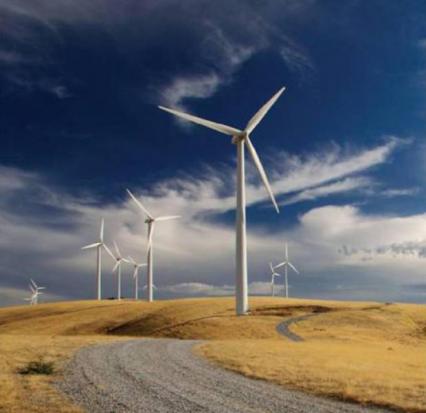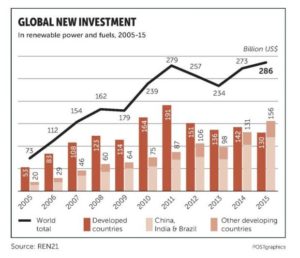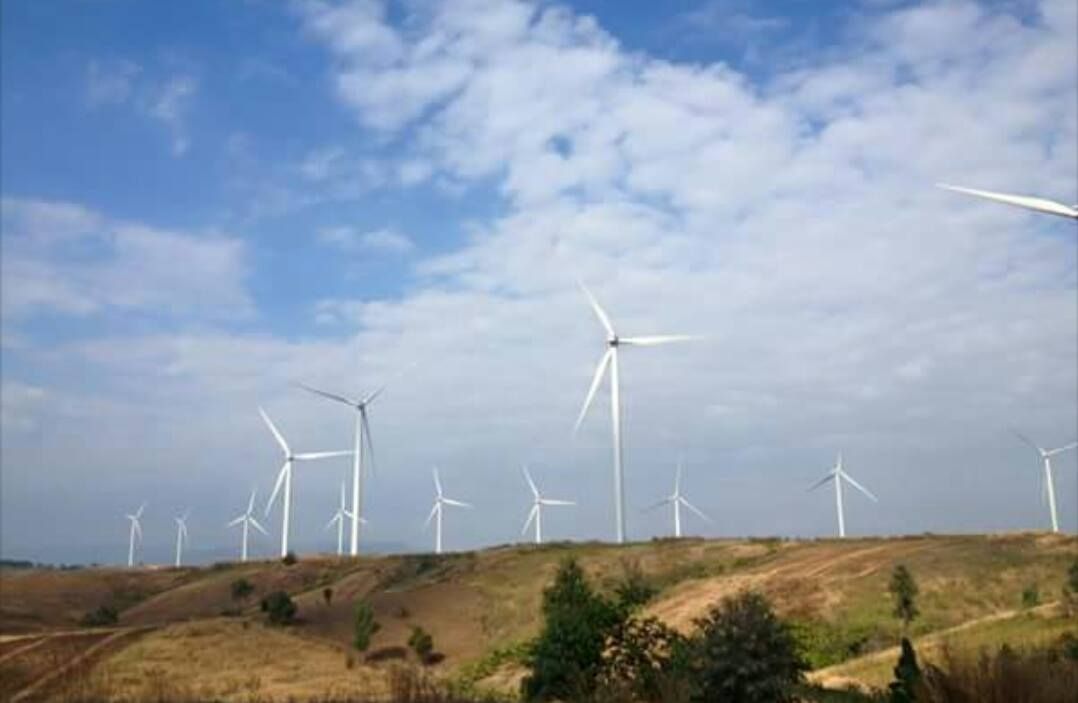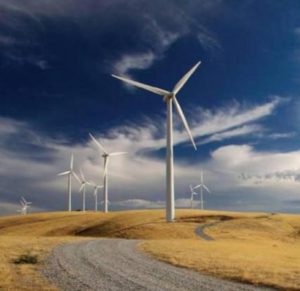
The case for renewable energy grows stronger as technology improves and costs fall, to the point where even conventional energy companies can’t ignore the opportunity for profit.
While traditional energy sources still represent about 76% of global electricity production, the world today is seeing a major shift toward cleaner and more cost-competitive renewables, thanks to the plummeting cost of technologies and pro-environment policies.
Use of renewables is at a record high with large-scale utilities leading the way. The International Renewable Energy Agency (Irena) reports that generation from renewable sources increased by 152 gigawatts (GW) or a record 8.3% in 2015. Overall, capacity has increased by roughly one-third over the last five years, with most of the growth coming from new wind and solar installations.
“The future for renewable energy in Asia looks quite rosy. Developing countries are leading the field in terms of addition of renewable energy capacity, particularly in China and India,” said Peter King, senior policy adviser with the Institute for Global Environmental Strategies (IGES).
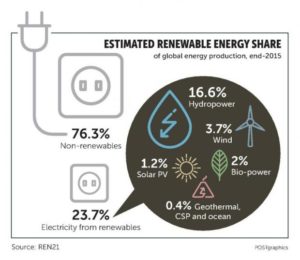 Net capacity installations from renewable power — hydropower, wind, solar, biomass, geothermal and other sources — are now higher than from all fossil fuels combined, according to the renewable energy policy network REN21. Renewable capacity accounted for nearly 24% of global electricity generating capacity in 2015.
Net capacity installations from renewable power — hydropower, wind, solar, biomass, geothermal and other sources — are now higher than from all fossil fuels combined, according to the renewable energy policy network REN21. Renewable capacity accounted for nearly 24% of global electricity generating capacity in 2015.
Renewable investments excluding large hydropower plants in the developing world totalled US$156 billion, up 19% from 2014, while developed nations invested $130 billion, down 8%, according to the Frankfurt School-Unep Collaborating Centre for Climate and Sustainable Energy Finance and Bloomberg New Energy Finance.
“Renewable investments in Asia are driven by the need to increase energy capacity. Countries in the region try to balance the different technologies with diversification of supplies,” said Antonio Castellano, associate principal at McKinsey & Company who co-leads McKinsey’s electric power and natural gas practice in Southeast Asia.
In the past, most new capacity in Asia came from traditional sources such as coal and gas, which were more cost-competitive, but renewables have been picking up rapidly.
“Renewables, in particular solar and wind, have been foreseen for the last decade as the major source of growth in the electricity sector across the globe. The pace of renewable growth has far exceeded any optimistic expectations,” Mr Castellano added.
Most of the growth in the last 10 years came from mature economies, notably in Europe, led by drivers such as regulation, CO2 abatement, security of supply and falling technology costs.
“Asia has started to develop renewables mainly in the last three to five years,” he said. “The region is picking up much more, led mainly by China and India. We see the national plans for most countries seeing sizable growth for renewables.”
Irena said that in 2015, Asia accounted for 58% of new installations worldwide, which has increased capacity by 12.4%, compared with 5.2% in Europe and 6.3% in North America.
BETTER TECHNOLOGIES
The continued advances in renewable technologies have been the main growth driver in Asia, according to Gerard Carew, vice-president of sales for Asia Pacific with Vestas, a Denmark-based wind energy specialist.
“In the past, Asia hasn’t been an area targeted for wind energy because Asia has lower wind speed throughout the region so a low¬-wind-speed turbine project may not be viable in Southeast Asia,” he explained.
“But now opportunities are starting to present themselves because of the improvement in wind turbine technologies with larger machines, greater rotor diameters and the ability to harvest more wind.”
Larger turbine diameter allows a machine to harness more wind and increase energy output. Mr Carew said a 90-metre rotor diameter was the biggest that Vestas could offer few years ago, but now it has grown to 136 metres.
“The viability of projects has changed considering the amount of wind that can be harvested with the rotor of this size. The technology has improved dramatically over the last five years,” he said.
For some parts of Asia, Mr King of IGES said wind turbines may not be the best option as wind strength in Southeast Asia is relatively weak compared with countries in the northern hemisphere, and there’s a high risk of natural disasters such as typhoons and massive storms that could damage the infrastructure.
“Solar is going to be an alternative option given that the price is going down so rapidly,” he said adding that solar generating costs had fallen from $359 per megawatt hour in 2009 to $79 in 2014. “That’s how quickly the price is going down and there is potential to go down further.”
Deutsche Bank has forecast that solar will be the next dominant electricity source globally and will generate $5 trillion in revenue by 2030, with more than 100 million customers added. By 2050, it said solar would have 30% of the market with most of the growth in developing countries.
Rum Herabat, chief executive officer of the SET-listed Ratchaburi Electricity Generating Holding Plc, said renewable energy, especially solar, had strong growth potential in Thailand as the country is aiming for alternative sources to account for 20% of the total generating capacity or around 19,000 megawatts (MW) in the next 20 years.
Under the current Power Development Plan (PDP), solar capacity would increase to 6,000MW by 2036, from nearly 1,300MW in 2014, with wind to reach 3,000MW from 225MW.
At Ratchaburi, Thailand’s largest private power producer, the share of renewables is forecast to double to 20% of its total generating capacity in 10 years from projects in Thailand and abroad, notably in Australia.
INVESTMENT SOARING
Global investment in renewables has been soaring, with net investments for renewable capacity outpacing fossil fuels for the past six years. Investments, led by wind and solar, reached $285.9 billion last year, beating the previous high of $278.5 billion in 2011.
Financial institutions have also become more active in granting loans for green projects while offering new vehicles such as green bonds and crowdfunding.
In Southeast Asia, for instance, another $1.5 billion is expected to go into the new 600MW Monsoon Wind Power Project in Laos developed by Impact Energy Asia Limited (IEA), a subsidiary of Impact Electrons Siam (IES).
This 68,000-hectare project, planned for commercial operation in 2020, is the first of its kind in Laos and will become Southeast Asia’s largest wind farm.
“We are trying to build a project that can prove to us all that sustainable renewable energy is something that will be competitive with any fuels without any subsidies,” according to Peck Khamkanist, chief executive officer of IES.
The project sites in Sekong and Attapeu are promising sources of wind energy and can generate power that can be sold to Southeast Asian markets, primarily Thailand and neighbouring countries.
“We want to offer a clean energy with a price that is competitive,” said Mr Peck, adding that for renewables to be sustainable, they must be able to compete with any fuels.
“The initial perception that renewables are difficult and expensive is the common denominator worldwide,” said Inigo Sabater, vice-president for global business development of Vestas.
“But this is changing. Most of the investments for new power generation today go to renewables. In the US, China and Europe, for instance, massive investments are going into renewables as the main form of power generation. And By 2020, 20% of all energy generation in Europe will come from renewables.”
Mr Sabater added that even the largest oil and gas producing countries are embracing renewables. “Sudan and Saudi Arabia, for example, are targeting 5GW and 9GW by 2030 respectively. It’s competitive, reliable and good business,” he said.
COSTS PLUMMETING
The biggest bottlenecks for renewable energy in the past were the incremental costs of building generators, which are more costly than traditional power stations, while storage costs also used to be very high.
However, improved technologies have brought the cost down dramatically for both generation and storage, said McKinsey’s Mr Castellano. As a result, both grid and end-user prices are comparable. “There is no expected substantial price increase related to renewable penetration,” he said.
The financial advisory firm Lazard says wind and utility-scale solar continue to be cost-competitive with conventional sources, despite large decreases in oil and gas prices. The costs of all forms of utility-scale solar photovoltaic and wind technologies have declined by about 80% and 60% respectively since 2009.
“Renewable energy will not bring up the overall electricity cost because the generating cost will be competitive with coal-fired or gas-fired power plants,” Mr King added.
The emergence of cost-competitive storage will also be the next catalyst for renewable adoption, according to Deutsche Bank.
In terms of stability, Mr Peck said wind energy can work well with other forms of energy as it can be predictable. The mean average error of prediction is less than one percent.
“In countries with a well-established grid with a nearly 100% electrification rate, there is potential storage on the existing grid system. In a place where grid systems are not well established, mini-grids are recommended,” added Mr King.
Mr Rum of Ratchaburi agreed, saying that advances in technology had helped boost the capacity factor of renewable energy projects by 20-30%.
“At present, the cost per unit of wind and solar is about $2 per megawatt and the prices are likely to decline further in the near future,” he told Asia Focus.
Thailand, meanwhile, still relies on natural gas for about 68% of its power generation. Two thirds of that gas comes from the Gulf of Thailand and the rest from Myanmar, but the latter now needs more gas for its own rapid economic development.
“Thailand needs to diversify sources of energy and renewable energy is among the best options,” said Mr Rum.
Coal and nuclear energies face a tougher road for future development in Thailand given strong protest from communities and environmentalists.
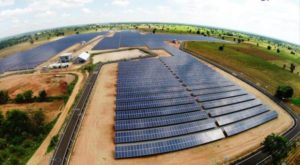
POLICY STRUCTURES
However, the adoption of modern and clean energy can only succeed if it’s supported by rational and transparent regulatory frameworks. European countries, for instance, have shown that renewable energy providers can bid successfully for power procurement in an open market.
“Setting clear development goals and attractive investment schemes have shown to be strong enablers driving successful renewable adoption in Europe and the US,” said Mr Castellano.
He cited the example of the European 20-20-20 target, which entails a 20% reduction in CO2 emissions and a 20% increase in energy efficiency with 20% of consumption from renewables.
“Setting a very clear target as such works very well in Europe,” he said.
To encourage investment, Mr Castellano said there needs to be clarity on long-term renewable regulation and attractive price schemes.
A key tool is the feed-in tariff (FIT), which requires utilities to purchase power from independent generators. The price will be fixed and set by regulators according to the cost of renewable technology.
However, the problem with FIT schemes, according to Mr Castellano, is that fast-paced development of renewable technologies means fixed payments can quickly become more expensive than they should be as costs fall.
Dr Matthias Lang of the international law firm Bird & Bird LLP cited the example of Germany, where a homeowner with a small rooftop solar system who signed a FIT contract in 2009 had a cost of 43 cents per kilowatt-hour through 2029 while the cost of a similar system installed last year fell to 13.7 cents.
“What we see working is the combination of a strong commitment to renewables, ensuring volumes, and open and transparent auctions. That has been a great benefit for the country and users. We see open competition for projects clearly pushing prices down,” Mr Castellano added.
Mr King said the key challenge in Asia has been the over-reliance on subsidies. The unsubsidised cost of electricity for solar, wind and hydropower from a utility-scale operation is now competitive with that of fossil-fuel power stations with comparable capital and operational costs.
“We are not dealing with a level playing field for all different technologies,” he said.
Mr Rum said that in his view, government support and bank loans are not the issue for renewable energy providers in Thailand because such projects received good support from prospective lenders and the government.
The challenges of renewable energy in Thailand, he says, are conflicts with local residents where projects are located. Solar, for instance, also requires a large area for development, while wind farms can be noisy.
Peter Jørgensen, vice-president of international relations for the Denmark-based energy company Energinet.dk, said that 30 years ago, his country relied for most of its energy on large coal-fired power plants, but now relies about 42% on wind power.
“There has to be an efficient transition to renewables. The government has to create the right incentives for investors,” he said. “It’s also a mental process, a paradigm shift to renewable energy adoption.”
The Danish electricity system relies on open market with a level playing field for generators and traders. “We are part of the international market interconnected with neighbouring countries,” he said.
“Renewables could make up a higher percentage in the global energy mix than what exists today. We need to educate people that renewables are a viable source and a mainstream technology that can be easily integrated into the grid system. There are real live working examples of that in other countries around the world,” concluded Mr Carew of Vestas.
Source: http://www.bangkokpost.com/business/news/1049505/cleaner-energy
